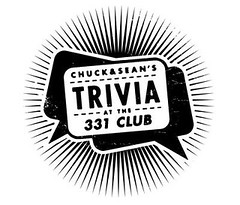 Conrad's book -- which reads like a martini encyclopedia -- includes an excerpt from My Last Sigh by filmmaker Luis Buňuel, who explicitly links the drink to religion: "Like all cocktails, the martini, composed essentially of gin and a few drops of Noilly Prat, seems to have been an American invention. Connoisseurs who like their martinis very dry suggest simply allowing a ray of sunlight to shine through a bottle of Noilly Prat before it hits the bottle of gin. At certain periods in America it was said that the making of a dry martini should resemble the Immaculate Conception, for, as Saint Thomas Aquinas once noted, the generative power of the Holy Ghost pierced the Virgin's hymen 'like a ray of sunlight through a window -- leaving it unbroken.'"
Conrad's book -- which reads like a martini encyclopedia -- includes an excerpt from My Last Sigh by filmmaker Luis Buňuel, who explicitly links the drink to religion: "Like all cocktails, the martini, composed essentially of gin and a few drops of Noilly Prat, seems to have been an American invention. Connoisseurs who like their martinis very dry suggest simply allowing a ray of sunlight to shine through a bottle of Noilly Prat before it hits the bottle of gin. At certain periods in America it was said that the making of a dry martini should resemble the Immaculate Conception, for, as Saint Thomas Aquinas once noted, the generative power of the Holy Ghost pierced the Virgin's hymen 'like a ray of sunlight through a window -- leaving it unbroken.'"The martini may be an American invention, but this drink's true paternity is hard to pin down. Like any rags-to-riches orphan -- and the martini is just that -- there will be someone out to claim him as their very own. As one example, Conrad mentions "a zealous group" in the town of Martinez, California in 1992 that "installed a brass plaque on the corner of Alhambra and Masonic" naming Martinez as the birthplace of the martini. This is the result of the following story: "Citizens of Martinez, California, claimed that around 1870 a miner from San Francisco stopped his horse at Julio Richelieu's saloon on Ferry Street in Martinez for a bottle of whiskey. Richelieu was a young Frenchman who had come up to Contra Costa County from New Orleans. The miner plunked a tobacco sack of gold nuggets on the bar near the weigh-scales and handed Richelieu a bottle. The bartender filled the container with whiskey from a large barrel, but the traveler said he wasn't quite satisfied. To make up the difference, Richelieu picked up a glass, mixed him a small drink, and dropped an olive in it. 'What is it?' asked the miner. 'That,' replied Richelieu, 'is a Martinez cocktail.'" Conrad clearly finds this particular story suspect and provides other stories, as well as his own theories to the origins of the martini. His book is something of an omnium gatherum of martini lore, filled with smart jokes, interesting historical tidbits, short stories, dazzling quotes, and boozy philosophizing.
"Martini Culture is not about getting stinking drunk and slipping under the table with a burp and a curse," writes Conrad. "It's about grace under pleasure. The idea is to make the rest of the evening more pleasant -- not to obliterate it. Richard 'Mr. Rick' Fishman, founder of San Francisco's floating party known as 'Mr. Rick's Martini Club,' says, 'A martini is like a woman's breasts: one is not enough and three are too many.'"
Conrad writes of famous martini drinkers. In the evenings, he tells us, W.C. Fields "would perform a trick of balancing a full Martini glass on his head." If the glass moved while he stood for a count, he would know that he had had enough for the day. However, "his skill and self-command were such that the glass rarely shook, and he then rewarded himself by emptying the contents." This a man who, estimated by biographer Robert Lewis Taylor, drank roughly two quarts of gin daily.
Conrad also discusses the various techniques for making a cocktail. He describes special techniques designed to pour an especially dry martini, such as "in and out," in which the mixer simply coats the shaker with vermouth and pours out the rest. And, on the subject of ice, Conrad quotes an excerpt from For the Wayward and Beguiled, in which author Bernard DeVoto writes, "Sound practice begins with ice. There must be a lot of it, much more than the catechumen dreams, so much that the gin smokes when you pour it in ... Fill the pitcher with ice, whirl it till dew forms on the glass, pour out the melt, put in another handful of ice. Then as swiftly as possible pour in the gin and vermouth, at once bring the mixture as close to freezing point of alcohol as can be reached outside the laboratory and pour out the martinis."
And, as if the martini were trying to break its own cool record, in 1965 it actually became a spy. Conrad includes an excerpt from Patricia Holt's The Bug in the Martini Olive: "The glass held a facsimile of an olive, which could hold a tiny transmitter, the pimento inside the olive, in which we embedded the microphone, and a toothpick, which could house a copper wire as an antenna. No gin was used -- that could cause a short.
"Our point was that a host could wander through his own party, having drunk his own martini, and pick up the conversations that were directed at him, or leave his glass near a conversation he could then monitor in secret. We wanted to show the vast proliferation of this equipment, and the bug in the marini olive was once a very fashionable example of many ... I felt I had introduced a new toy, like a play-chew for a dog. [the reporters and photographers] couldn't stop gnawing at it."
Yet another excerpt from The Martini, this time from J.A. Maxtone Graham, demonstrates the pleasing effect of the drink. "A party of thirty-six ladies from Stockton, California, were at the peak of their Martini happiness when two armed burglars broke in and announced at gun point that they would take away all the ladies' jewelry and money. There was no correct response from the party-makers, who merely asked the intruders to join them for a drink. Baffled by the whole affair, the burglars left empty-handed, and the party continued unabated."
We have our own theories as to why these gun-wielding scofflaws left such a party. Perhaps the burglars left because they didn't agree with how the ladies were mixing their martinis -- not enough ice, perhaps? Or perhaps the women were shaking the martini, and the burglars preferred theirs stirred. Perhaps that party's hosts were committing the monstrous act of passing off a vodka drink as a martini, and the burglars simply could not endure this. If they were smart burglars, though, they'd have come back with some decent gin, a mountain of ice, and more damn olives. (MAULT)

 2 oz. whiskey
2 oz. whiskey


1 comment:
Conrad's book is a fantastic read. It's worth it for the anecdotes alone, but the rest of the book is also wonderful.
Anyone interested in drink lore should own a copy.
Post a Comment